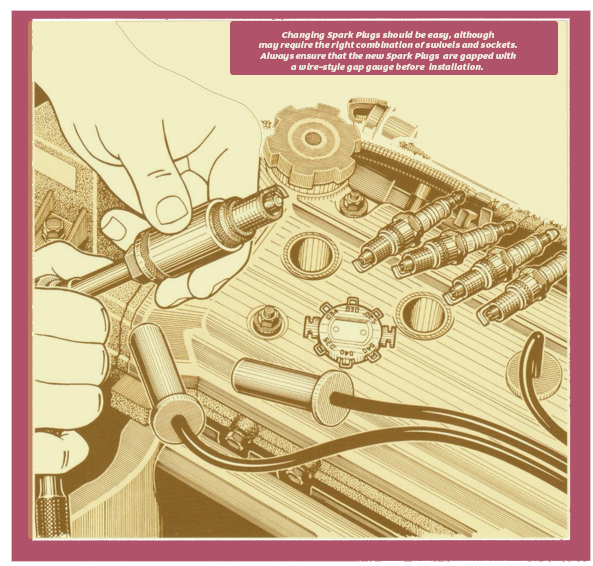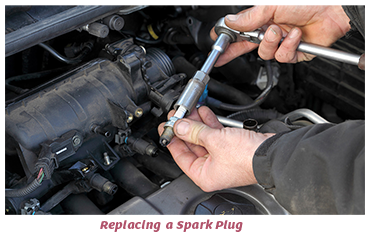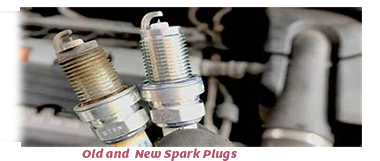 Signs that it is time to change spark plugs in a classic car begin when the vehicle’s engine is no longer idling smoothly. If not attended to, eventually the engine will begin to experience significant misfires, it's more than likely that a faulty spark plug (or plugs) is the culprit.
Signs that it is time to change spark plugs in a classic car begin when the vehicle’s engine is no longer idling smoothly. If not attended to, eventually the engine will begin to experience significant misfires, it's more than likely that a faulty spark plug (or plugs) is the culprit.
 Hearing a misfire can be challenging, and while changing plugs is straightforward, it may require certain skills as well as a specific set of swivels and sockets for your ratchet, especially when working on V-engines. It's important to check the gap of a new plug using a wire-style gap gauge before installation.
Hearing a misfire can be challenging, and while changing plugs is straightforward, it may require certain skills as well as a specific set of swivels and sockets for your ratchet, especially when working on V-engines. It's important to check the gap of a new plug using a wire-style gap gauge before installation.
 Control standards necessitate that the engine computer's on-board diagnostics (OBD) record trouble codes for each cylinder. Nonetheless, the initial vehicles featuring that system (known as OBD II) were not manufactured until 1994, and the majority of cars did not incorporate it until 1996.
Control standards necessitate that the engine computer's on-board diagnostics (OBD) record trouble codes for each cylinder. Nonetheless, the initial vehicles featuring that system (known as OBD II) were not manufactured until 1994, and the majority of cars did not incorporate it until 1996.
It's important to check for trouble codes that may indicate an issue with the engine, especially those related to the oxygen sensor, even if you have an earlier model going back to the Sixties. If you're experiencing a decline in engine performance, and the spark plugs have been in use for a couple of years or around 30,000 miles, it is common practice to remove them for inspection. It's important to have pliers that can securely grip the end of the boot, providing you with a solid hold.
 Another important aspect to consider is ensuring that your spark-plug socket is the correct fit. To align with the latest standards, many new plugs are now longer than what you might be accustomed to. A worn or outdated socket might not securely accommodate the hex, which could lead to slippage and potentially damage the plug. Using a socket with a rubber insert can effectively secure the plug-in place.
To remove and replace spark plugs it is recommended to start, with a warmed-up engine.
Firstly, compressed air should be used to clean the plug hole recesses, after which all the spark plugs should be loosened by a quarter turn, allowing the engine to cool down. Removing spark plugs from a hot cylinder head has been known to damage of the threads.
Another important aspect to consider is ensuring that your spark-plug socket is the correct fit. To align with the latest standards, many new plugs are now longer than what you might be accustomed to. A worn or outdated socket might not securely accommodate the hex, which could lead to slippage and potentially damage the plug. Using a socket with a rubber insert can effectively secure the plug-in place.
To remove and replace spark plugs it is recommended to start, with a warmed-up engine.
Firstly, compressed air should be used to clean the plug hole recesses, after which all the spark plugs should be loosened by a quarter turn, allowing the engine to cool down. Removing spark plugs from a hot cylinder head has been known to damage of the threads.
After removing the plugs, a moment should be taken to carry out a final examination should be carried out to ascertain if they still have significant life remaining. This can be done by utilising a magnifying glass and a feeler gauge to ensure accuracy. If the gap exceeds .005 in. beyond the specifications, and there is noticeable rounding of the centre electrode along with wear on the side electrode, it's advisable to install new plugs.
 If any spark plugs appear dry-soot black, this indicates an issue with carbon, typically related to a rich-fuel mixture problem. If a trouble code suggests that the oxygen sensor is incorrectly indicating a lean condition, it's possible that the sensor is at fault. If the indication of a rich mixture is accurate, it's important to investigate potential causes, such as leaking fuel injectors or an engine misfire. A misfire tends to release a significant amount of unburned fuel into the exhaust, and that is indeed the case. However, it also introduces a significant amount of oxygen.
If any spark plugs appear dry-soot black, this indicates an issue with carbon, typically related to a rich-fuel mixture problem. If a trouble code suggests that the oxygen sensor is incorrectly indicating a lean condition, it's possible that the sensor is at fault. If the indication of a rich mixture is accurate, it's important to investigate potential causes, such as leaking fuel injectors or an engine misfire. A misfire tends to release a significant amount of unburned fuel into the exhaust, and that is indeed the case. However, it also introduces a significant amount of oxygen.
If the plugs appear to still have some life left in them and can be reinstalled the old plugs, it's advisable to apply a thin layer of antiseize on the threads close to the tip.
This procedure is not necessary with new plugs as they come with a coating designed to lubricate the threads during installation, helping to prevent the plug from seizing during future removals, although this benefit is only effective for the first installation.
 The appropriate plug for any vehicle is and remains is the specific part number that the manufacturer originally installed at the factory. When the time comes to retire them, you'll need to select from a variety of manufacturers' options, which ostensibly appear to be quite similar, although that assumption would be far from correct. There are nuanced differences in a plug's capacity to dissipate heat that reveal distinctions beyond what might appear to be a precise physical match.
The appropriate plug for any vehicle is and remains is the specific part number that the manufacturer originally installed at the factory. When the time comes to retire them, you'll need to select from a variety of manufacturers' options, which ostensibly appear to be quite similar, although that assumption would be far from correct. There are nuanced differences in a plug's capacity to dissipate heat that reveal distinctions beyond what might appear to be a precise physical match.
A "hot" plug features an extended pathway through the ceramic to the comparatively cooler cylinder head, while a "cold" plug features a shorter heat-conduction path, which generally results in it operating at a cooler temperature.
 Spark plug manufacturers often cross-reference their product lines with those of other manufacturers, making it possible to find a suitable plug for nearly any application using the cross-reference chart. While heat range is certainly a factor, aspects such as thread diameter, length, and the type of tip hold greater significance.
Spark plug manufacturers often cross-reference their product lines with those of other manufacturers, making it possible to find a suitable plug for nearly any application using the cross-reference chart. While heat range is certainly a factor, aspects such as thread diameter, length, and the type of tip hold greater significance.
Fitting an incorrect plug can quickly damage your engine if the plug is too long and strikes the top of the piston, particularly with modern aluminium heads. A plug that is too short will not ignite properly, and carbon buildup can quickly accumulate in the threads of the cylinder head, making it difficult to install the appropriate plug later on.
Back to the homepage- and don't spare the horsepower.
ae4


